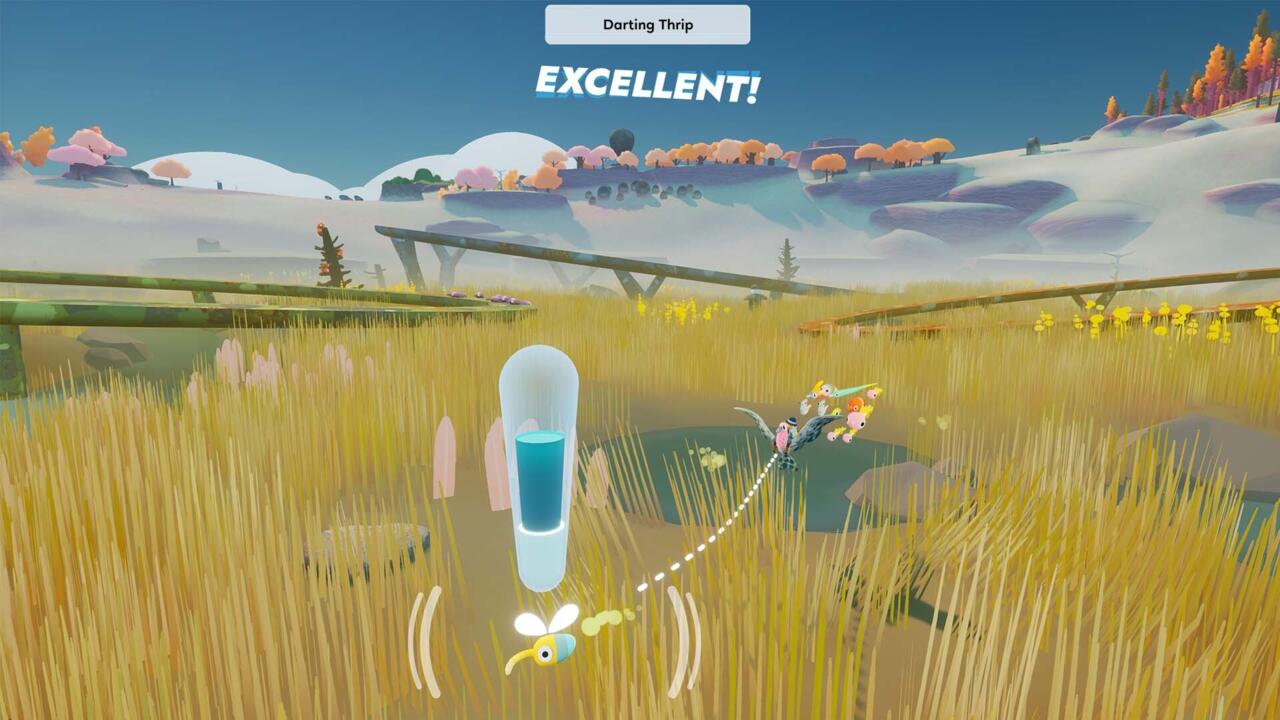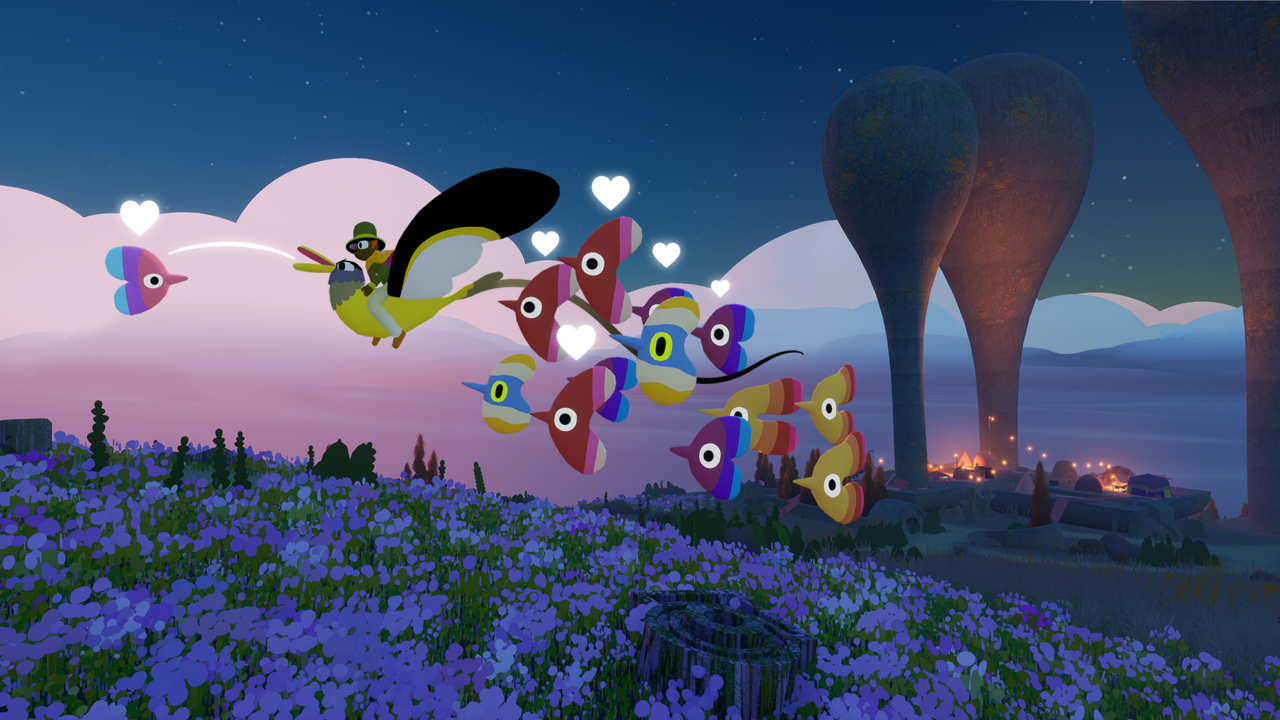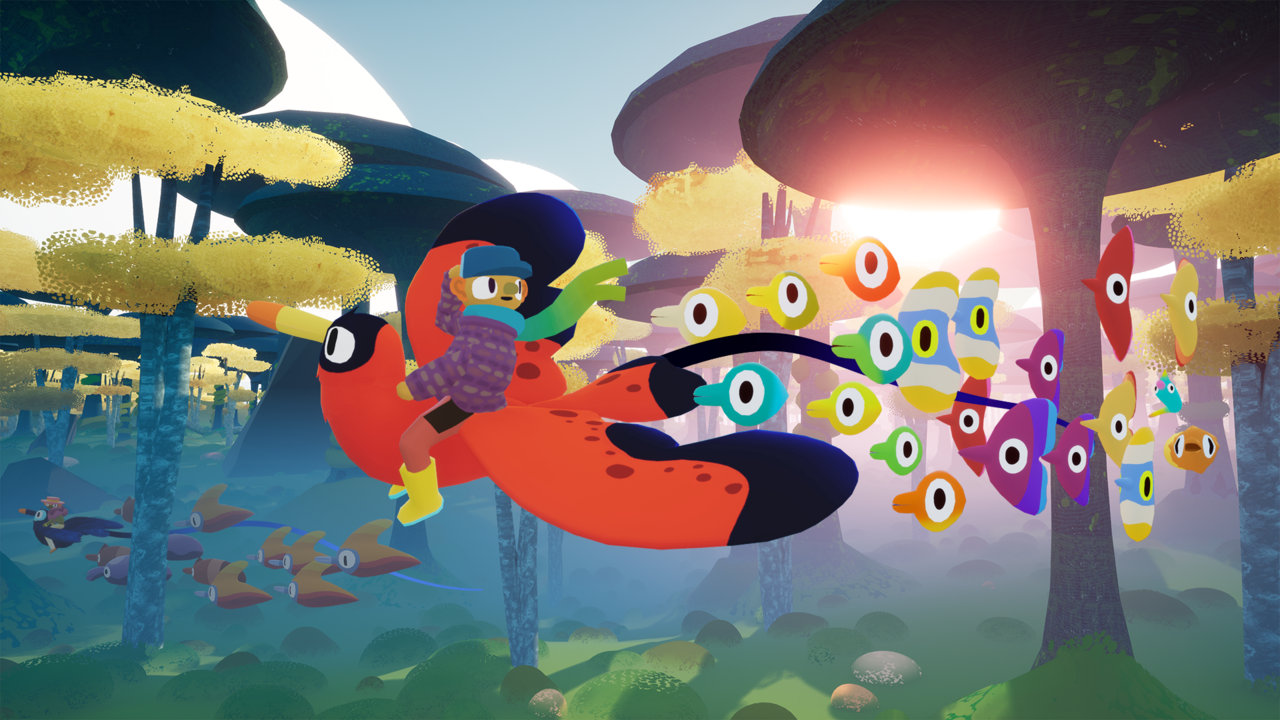The creature-collector genre is dominated by Pokemon and filled out from there with many games heavily inspired by it. Through a certain lens, Flock is a creature collector, too, but if you go into it looking for a game very much like Pokemon, you won’t find it. The task of filling out your Pokedex-like Field Guide by discovering a world of (mostly) fantastical creatures, each with their own physical and behavioral traits, is very much like the genre’s titan, but beyond that, Flock is much more lax, not to mention charming and delicate. It’s better described as a creature observer, and that novel approach winds up being very enjoyable.
Flock takes place in a gorgeously colorful wilderness called The Uplands. As the customizable player character and bird-rider, you and an optional co-op partner head into a small camp where your aunt and some pals need your help cataloging the many critters roaming the land. The entire game takes place on the back of your feathered friend, and the game’s way of automatically adjusting your flight path vertically, while you do so horizontally, makes it all very easy to control. It feels light and fun in your hands, like going down a slide at the playground.
This child-like spirit is present throughout the game, from its candy-colored trees and plains to its small cast of characters who speak mostly in terms players of all ages can understand, but who occasionally pack a hint of something more grown-up in their musings. I found it similar to how characters on many Cartoon Network shows speak. It isn’t trying to be subversive, like a Dreamworks movie sneaking in an adult joke; rather, it treats its audience with some maturity, expressed in the words characters choose. It’s immediately inviting, and the game’s soft music makes for a perpetually calming soundtrack that keep game feeling meditative and decompressing.
Effectively, this creature collector is more akin to a bird-watching game, though I hesitate to call it a “simulation” since you’re riding on a bird and observing animals that don’t exist on Earth, and you do it all with pretty simple mechanics. There are a dozen species to discover, such as Bewls, Sprugs, Drupes, and more, and each time you encounter a new critter, you’ll be asked to guess which family they belong to and specify which type they are.
Not all Drupes are identical, after all; you may guess you’ve found yourself such an animal, but are they a Wandering Drupe, a Balsamic Drupe, a Yellowlegs, or another kind? This is resolved by observing their behavior and appearance, then choosing their identity from a list of short descriptions of each type of Drupe. You’ll get two tries, after which point the game (via your aunt’s forgiving instruction) just tells you the right answer.
Naturally, the names of some creatures are helpful–the Yellowlegs has yellow legs, of course. But sometimes, more than one animal in a species may have a particular trait, which means you’ll want to inspect a bit more closely. Do they have a unique gait? Do they change colors? Do they travel in small groups? Since the game equips you with some pertinent details of each animal before you’ve even met any of them, choosing the right one from the list is generally easy even if some are a bit tougher than others to differentiate.
And more than being easy, it’s forgiving. There’s no penalty for getting anything wrong, and neither is there a gamified reward for getting things right. It all feels very purposely low-stakes, and I appreciate it for that. Flock is a video game and does some video-gamey things, but it’s never really keeping score. There are few fail states and no game-over screens. You’re given a charming world to discover, which for me is reliably rewarding enough.
Where discovering an animal is the first step, and identifying them is the second, charming them is the third. To charm any animal, you’ll need to know their call, which you learn by finding whistles scattered across the world. Both finding whistles and using them is, like identifying animals, extremely easy. In the former’s case, you’ll send your sheep out to eat domes of grass, thereby revealing a Burgling Bewl–a critter known to run off with people’s belongings–who then forks over their pilfered item.

Retrieving your aunt’s 12 whistles means you’ll eventually be able to charm any species in the game, which is done via a brief minigame in which you try to line up some on-screen shapes and play the notes at the right time, effectively making it a quick-time event. You can actually fail these, which means alarming the animal and sending them scurrying off. But the number of animals in the world is not finite; another will soon appear if you zip around their habitat for a bit.
As you progress, the clouds coating the landscape will dissipate to reveal new biomes, some of them home to specific types of animals or even whole species you haven’t seen yet. Each biome also houses more researchers like yourself, NPCs who offer you tips and trade challenges for wool, which can also be gathered from your sheep and used as currency to unlock silly clothing options like “Mustard Style” clothes, a line of hats, shirts, and more all predominantly colored like the condiment.
While I thoroughly enjoyed all of these simple tasks, one of the game’s best aspects happens to be a bit more complex. The process of finding the dozens of different animals can sometimes demand very specific antecedents, like checking in a specific biome at a certain time of day, or perhaps only spotting them from some distance away using the game’s focus mode, as some animals are shy or standoffish.
One particular animal must be found by following trails of elusive smoke; another is only discovered after you investigate a number of colorful and oily markings; and another blends in like drooping fungi in a mushroom forest. I haven’t found every last one of them yet, but the act of meeting each and every type of animal in the game is actually more enticing as the game goes on, as the final handful can be particularly tricky.
In this way, Flock works opposite many other games. Whereas normally obtaining every last collectible item in a game feels like an increasing grind as the game goes on, in Flock, I very much want to complete my Field Guide. With 55 animals in the game, many of them offer these more involved steps and make for the game’s most-earned discoveries. There are even a few who are so rare that they haven’t a name yet, allowing you to select their name from a list of several suggestions, each of them carrying the game’s cozy and welcoming vibe forward.
A lot of creature collectors cast the player-character as a powerful human who lords over their captures and sends them into battle to earn human-centric rewards, a formula that has not just fatigued me, but long made me uncomfortable. Refreshingly, Flock feels more like an ecosystem, one in which you are a member but never the ruling body. You don’t capture animals, you just hang out with them. When charmed, they trail behind you, creating a parade of diverse animals. There is neither hurt nor dominion in Flock’s Uplands. You aren’t there to grasp nature and empower yourself. You’re there to study the world and help a family member in the process. That’s all, and that change of pace and point of view is one of my favorite parts of the game.

My gripes with the game are few in number. Though the game’s objectives are frequently easy enough, some instructions are only given in dialogue with NPCs, and if you miss some pertinent information, there’s no way to recall or play back what you were told, and the quest log sometimes doesn’t say either. This once led to me being stumped for a while when I unlocked a new biome and then didn’t know where to focus, having overlooked a line in which my objective was hinted at.
I also consistently forgot to recall my sheep after they’d eat up some of the pasture to help me reveal Burgling Bewls. I never saw a reason for these sheep to need me to actively recall them from a design perspective, which meant some occasional frustration when I’d zoom across the land to complete a task, only to realize too late that I’d left my sheep on a hill some hundreds of meters away. It’s not a big open world, so neither is it a big problem, but it seems like the sheep should just return to me after they’ve cleared the hilly pasture and I’ve claimed my reward hidden beneath the tall grass. Having said that, these are minor annoyances that didn’t hinder my experience for too long in any instance.
Flock’s mostly simple mechanics and colorful world mean it all plays like a hug. With its low barrier of entry, people of all ages and skill levels can enjoy the game, and in two-player co-op, even enjoy it together. When things do get a bit more complex, that leads to some of the game’s most rewarding moments, like discovering and naming super-elusive animals, or eventually filling out the all-important Field Guide with every critter and call seen and heard in the Uplands. Flock paints the picture of a world that welcomes you with open arms and equips you with tools to reciprocate the same admiration and respect for its dozens of interesting creatures.
